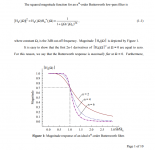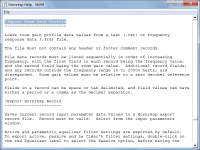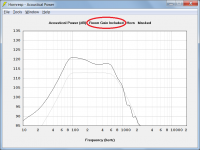A Bessel filter is maximally flat in the time domain rather than the amplitude domain (Maximally flat in time domain is called a butter-worth filter).
Unfortunately your prose seems to have a lot of clumsy self-contradictions as above.
Qtc<0.5 Overdamped
some might call these quasi-first order response
Qtc=0.5 Critically damped
There is still step (transient) overshoot, but it settles with no ringing
F6 = Fc = Fs*sqrt(Vas/Vb+1)
Qtc=0.577 Bessel (maximally flat delay)
This means highest Qtc with no peaking in delay
Qtc=0.707 Butterworth (maximally flat amplitude)
This is as you say, the highest Qtc with no peaking in amplitude
F3 = Fc = Fs*sqrt(Vas/Vb+1)
In the picture, case 1 is Qtc=0.5, case 2 is 0.577 and case 3 is 0.707
These responses are based on a driver that has an F3=Fc=100Hz for the Qtc=0.707 case and the box size is increased to make the other lower Qtc's. The left graph is amplitude, the right graph is group delay in seconds.
In my opinion, you would be hard pressed to tell the difference between any of these boxes in a room if the F3 were a more typical 40Hz or so rather than 100Hz. You might be able to tell with these at 100Hz.
Attachments
Last edited:
Unfortunately your prose seems to have a lot of clumsy self-contradictions as above.
I am sorry I made a slight mistake in my description (I am dyslexic so I think one thing and write another - unfortunately I do this all the time and if I read it back I read back what I meant to write rather than the mistake - it drives me mad as well!)
"
A Bessel filter is maximally flat in the time domain rather than the amplitude domain (Maximally flat in time domain is called a butter-worth filter)
"
Clearly this should have read - (Maximally flat in the amplitude domain is called a butter-worth filter)
Thank you for your correction. I avoided using mathematical descriptions as many people don't find them easy to understand. However thank you for clarifying the different mathematical models and more precise descriptions of the functions.
Possibly I should have use a fuller description of the functions however I was trying to get over the behaviours of the different alignments more than highly accurate descriptions. Anyway you have now done that for those that are interested.
Last edited:
In my opinion, you would be hard pressed to tell the difference between any of these boxes in a room if the F3 were a more typical 40Hz or so rather than 100Hz. You might be able to tell with these at 100Hz.
I think you would hear the difference even at 40 hz.
With my 6th order subs outside (f3 28 hz) if I set the subsonic from 32 hz to 30 hz it seems they go subjectively almost double as low when playing corresponding music.
Just those 2 hz make more difference than one might think.
There's not much left to be said in this thread because gfiandy has pretty much laid out all the issues. Sadly, I suspect it will be a total bear for many to make sense of. Too bad.
I hope everybody in this thread will read your post with the care it deserves because you've addressed 'most everything.
Maybe even Ron E and Doppler9000 will learn something.
Thanks.
B.
Ben,
Your remarkably frequent use of logical fallacies (alleged certainty, Argumentum ad populum, Ad hominem, etc.), rather than evidence, gives me the impression that your reach exceeds your grasp on these topics. Or, it could be you are an old crank. Or both.
For a purely mathematical look at Butterworth low-pass filters:
http://www.ece.uah.edu/courses/ee426/Butterworth.pdf
Attachments
Last edited:
+1I think you would hear the difference even at 40 hz.
Actually globalplayer, Ron E is playing a little game with us. He is speculating about tiny tiny boxes that the OP's 18-inch driver might barely fit into. Not the sensibly larger box that would help the two drivers OP has already bought* get closer to their resonance of 28.
Totally weird to me to box good woofers in tiny boxes just because your sim likes "maximally flat"... whatever that means.
B.
*nice drivers and a bargain, and will be pretty good. But gfriandy is right to - among many other wise points he makes - to say they aren't quite right here. When your nose is deep into paint-by-number sims, you risk loosing understanding and perspective. When a dealers says "Pro", they mean won't blow up in a disco rather than designed for domestic SQ
Last edited:
…"maximally flat"... whatever that means.
B.
Ben,
“Maximally flat” has been referenced and described multiple times. Why are you deliberately ignoring the information?
Ignorance plus arrogance is a particularly odious combination. All the more so when the ignorance is willful.
Something that the OP may not have considered, a small sealed box to force resonance higher and then EQ below, ie, Linkwitz's transform circuit Linkwitz Transform Subwoofer Equaliser or this Sub-Woofer Controller
Sure Doppler9000, it is now time for you stop being abusive and to put "meat on the table".Ignorance plus arrogance is a particularly odious combination. All the more so when the ignorance is willful.
Please tell us in a few well chosen words how to define "maximally flat" for ordinary amateur speaker builders, how much "maximally flat" you think most builders need at a cost to low freq extension, what's a good amount of "maximally flat" to have, can you have too much, what should OP do to improve "maximally flat", is it better to build a sealed box that is "maximally flat" or to build a bass-reflex that ain't flat at all, and so on.
If you are incapable of putting those thoughts together in your own words for the education of us all others, then I ask you stop posting abusive insults.*
B.
* and even if you can, I still ask you stop posting abusive insults. Ummm, same goes for Ron E
Last edited:
Sure Doppler9000, it is now time for you stop being abusive and to put "meat on the table".
If you are incapable of putting those thoughts together in your own words for the education of us all others, then I ask you stop posting abusive insults.*
B.
* and even if you can, I still ask you stop posting abusive insults. Ummm, same goes for Ron E
Ben,
I am sorry if you feel you have suffered abuses.
bentoronto said:Please tell us in a few well chosen words how to define "maximally flat" for ordinary amateur speaker builders, how much "maximally flat" you think most builders need at a cost to low freq extension, what's a good amount of "maximally flat" to have, can you have too much, what should OP do to improve "maximally flat", is it better to build a sealed box that is "maximally flat" or to build a bass-reflex that ain't flat at all, and so on.
Though the term has been defined adequately for those truly interested, I will point out an important aspect of the deficit of logic you demonstrate. It may be this that this shortfall helps explain your difficulties in understanding what is being discussed here.
“Maximally”, as used here and in general, is a superlative. If the specific mathematical conditions are not met, the function is not “maximally flat” i.e., it is not a Butterworth filter.
It might be easier for you to grasp the concept if we use the term “no ripples” instead of “maximally flat”, and re-examined your query.
bentoronto said:“…what's a good amount of "no ripples" to have…?”
Hopefully you can see that if you have any ripples, you no longer have “no ripples”, and would not have a Butterworth filter.
As all can now see from Doppler9000's post, "the emperor has no clothes". All we have is the Webster dictionary and not a single bit of useful guidance for speaker builders coming from him or Ron E.
For sure, a speaker builder needs to understand (at least roughly) the "Australian Model" and to grasp how driver parameters drive box design, at least conceptually if not numerically.
From that state of insight, a builder can then "paint by numbers" and model different outcomes so as to judge how much ripple they figure is OK*, is the "non-flat" part just at system resonance (in which case you just might really like to have more of it), how big a box can join their living room furnishings, are they strong enough to lift the darn thing, etc.
But one thing is certain, taking your "matching orders" from a sim screaming "maximum flat" is a mindless approach to system development.
B.
*I suppose if your room is small, the eigentones will be large; so what the heck, go with big ripples and go for the lower F3
For sure, a speaker builder needs to understand (at least roughly) the "Australian Model" and to grasp how driver parameters drive box design, at least conceptually if not numerically.
From that state of insight, a builder can then "paint by numbers" and model different outcomes so as to judge how much ripple they figure is OK*, is the "non-flat" part just at system resonance (in which case you just might really like to have more of it), how big a box can join their living room furnishings, are they strong enough to lift the darn thing, etc.
But one thing is certain, taking your "matching orders" from a sim screaming "maximum flat" is a mindless approach to system development.
B.
*I suppose if your room is small, the eigentones will be large; so what the heck, go with big ripples and go for the lower F3
“As all can see”? Wow - you really do love this logical fallacy.As all can now see from Doppler9000's post, "the emperor has no clothes".
Who is the Emperor in your imagination here?
Are you intentionally ignoring what has been written or is it simply beyond you?bentoronto said:All we have is the Webster dictionary and not a single bit of useful guidance for speaker builders…
Are you unable to do further reading? I excerpted and referenced an article above that is not from Webster which you seem to have ignored.
The term is “maximally flat” not “maximum flat” – no wonder you are so befuddled here – you can’t even keep track of the term in question from post to post.bentoronto said:But one thing is certain, (your favorite fallacy again!) taking your "matching orders" from a sim screaming "maximum flat" is a mindless approach to system development.
Who is taking marching orders from sims?
In any case, I know understand why so many respond with a simple “Huh” to your postings.
Last edited:
Answer: Only the lowest possible ripple (within the chosen compromise).a builder can then "paint by numbers" and model different outcomes so as to judge how much ripple they figure is OK
Double bass can go low, right into the most troublesome room modes (eigentones). Take a double bass from the concert hall and play it (or, preferably, ask someone to play it) in your room and you obviously will conclude that it is the same double bass from the concert hall, in spite of your room modes ("big ripples").But one thing is certain, taking your "matching orders" from a sim screaming "maximum flat" is a mindless approach to system development.
B.
*I suppose if your room is small, the eigentones will be large; so what the heck, go with big ripples and go for the lower F3
Now, reproduce in your room a concert hall recording from the same double bass thru:
A. Maximally flat loudspeaker
B. Loudspeaker with big ripples (i.e. not maximally flat), but with same F3.
C. Loudspeaker with big ripples (i.e. not maximally flat), but with lower F3.
What do you think, which reproduction is more faithful, A or B?
What if loudspeaker with big ripples and lower F3 (case C.) has ripples at the same frequencies as your room modes?
So, you can see now that maximally flat alignment is not so mindless approach.
Last edited:
Just sticking with 2-pi models, I think a least-mean-squares solution to the house curve is a sensible criterion.
B.
Well said, Ben.
Well said, Ben.
Great.
Now just a matter of McBean figuring out how to direct end-users to input house curves* and do the arithmetic.
Challenging, but can be done.
B.
*graphic user interface?
so what the heck, go with big ripples and go for the lower F3
Then, again, there are no ripples in the house curve. So, what are you proposing really?Just sticking with 2-pi models, I think a least-mean-squares solution to the house curve is a sensible criterion.
Last edited:
House curve is flat in the bass/mid range.Now just a matter of McBean figuring out how to direct end-users to input house curves* and do the arithmetic.
Do you know you are posting in the "Subwoofers"?
Magnificent Hornresp from McBean sims only in the low frequency range, as every other loudspeaker simulation software. But you don't know that...
Now just a matter of McBean figuring out how to direct end-users to input house curves* and do the arithmetic.
Is a "house curve" the same as a room gain profile?
Hornresp can import room/cabin gain data to add to the simulated response.
Attachments
- Status
- This old topic is closed. If you want to reopen this topic, contact a moderator using the "Report Post" button.
- Home
- Loudspeakers
- Subwoofers
- WHAT IF its somewhat Smaller? or Larger? Sealed Woofer Box and Frequency Response



